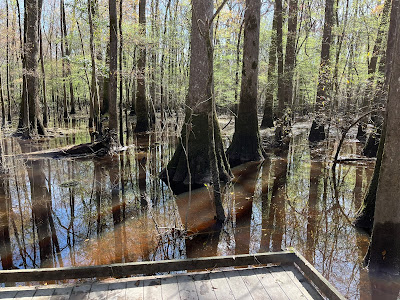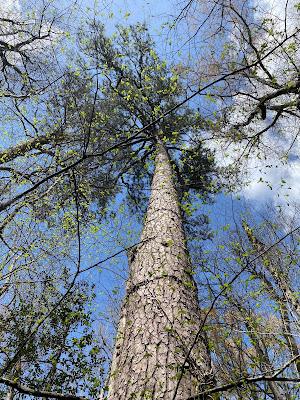Congaree is a relatively new National Park. It is also, until recently, one of the 10
fewest visited parks. This little-known
park protects and celebrates an ancient, splendid, and complex, old-growth flood-plane forest.
What makes this old-growth forest extraordinary is that
periodically the Congaree and the Wateree Rivers flood and the forest becomes
flooded as well. The flood waters deposit
silt, adding to 8 feet of nutrient rich mud called Dorovan
Muck. With rich soil, plentiful
water and a long growing season, the trees grow very tall here, it has the
tallest canopy (over 130 feet in height) on the East Coast.
Before European settlers came to the Southeast there were
35 million acres of old-growth flood-plane forests along many rivers including the Mississippi. Congaree holds the largest remnant of these
forests left, with only 11,000 acres.
That is less than one half of one percent of those magnificent forests. Congaree was
selectively logged for cyprus wood in the 1890s. Otherwise, Congaree remains an example of an untouched,
old-growth forest. Most of the park is protected
today as a wilderness area.
Loblolly pines are the tallest trees in this very tall forest
The ancient sweetgum, beech, swamp chestnut oak, holly, water tupelo, bald cypress and loblolly pine trees are well adapted to thrive in this wet environment. There are quite a few State and National Champion
Trees in the forest. A Champion Tree is
measured by girth (4.5 feet off the ground), height, and diameter of the tree canopy. They are dotted throughout this forest. Being the tallest trees, they stick up above
the canopy and are felled by lightening, storms or old age, and then other
trees become the Champions for their species.

Boardwalk closed from flooding AND a fallen tree

Note the stains on the trunks marking recent high water
Even though the forest floor here is often wet, it is not a swamp. Swamps are generally always wet, while a flood-plane forest like this one is only wet as the result of a flood event. We visited Congaree while it was flooded. It had been flooded for 12 days, and the waters were beginning to recede. You usually can walk along a 2.5 mile boardwalk loop. Parts of the boardwalk that we walked on were dry on the day of our visit, but had been flooded the day before. Parts of the boardwalk were still closed due to flooding. There are also a few surface hiking trails in an area call "the uplands" which can also flood.

Upland section of the boardwalk crossing a surface hiking path. Yes, the park is dog friendly.
Congaree is home to thousands of species of birds, insects,
reptiles, amphibians and mammals. There
are 27 species of mosquito alone – though it was still too cold for them while we
were there (phew!). In early summer, rare synchronous
fireflies flash in unison. The park holds
a lottery for visitors to come to see this unusual light show.
Congaree has an interesting human history as well. The earliest humans to visit Congaree were hunters and gatherers who found plentiful food. During the American Revolution, Brig. Gen
Francis Marion, known as the Swamp Fox, used these dense woods to conduct
gorilla warfare against the British, ultimately breaking the British hold on
the area. Later, people escaping from
slavery on nearby plantations established maroon settlements in the impenetrable
forest, where slave owners and slave catchers could not pursue them.
 |
| Cypress log from timbering in 1890s, found submerged in the river |
Some National Parks knock your socks off. Yosemite has iconic geology, Lava Beds has
acres of lava, Dinosaur has dino bone fossils sticking out of the rocks, and the Grand
Canyon has, well, the Grand Canyon.
Congaree is different; it is quiet, and subtle. Congaree seems on the surface very similar to
other Eastern Forests. However, it is something very special that we had never seen before. You could once have found forests like this along the banks of many rivers of the southeastern US, but they are all gone today. It was a
wonderful treat for us to visit, and we are so glad that it is protected as a national park.






No comments:
Post a Comment